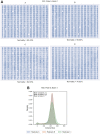ChemGAPP: a tool for chemical genomics analysis and phenotypic profiling
- PMID: 37014365
- PMCID: PMC10085634
- DOI: 10.1093/bioinformatics/btad171
ChemGAPP: a tool for chemical genomics analysis and phenotypic profiling
Abstract
Motivation: High-throughput chemical genomic screens produce informative datasets, providing valuable insights into unknown gene function on a genome-wide level. However, there is currently no comprehensive analytic package publicly available. We developed ChemGAPP to bridge this gap. ChemGAPP integrates various steps in a streamlined and user-friendly format, including rigorous quality control measures to curate screening data.
Results: ChemGAPP provides three sub-packages for different chemical-genomic screens: ChemGAPP Big for large-scale screens; ChemGAPP Small for small-scale screens; and ChemGAPP GI for genetic interaction screens. ChemGAPP Big, tested against the Escherichiacoli KEIO collection, revealed reliable fitness scores which displayed biologically relevant phenotypes. ChemGAPP Small demonstrated significant changes in phenotype in a small-scale screen. ChemGAPP GI was benchmarked against three sets of genes with known epistasis types and successfully reproduced each interaction type.
Availability and implementation: ChemGAPP is available at https://github.com/HannahMDoherty/ChemGAPP, as a standalone Python package as well as Streamlit applications.
© The Author(s) 2023. Published by Oxford University Press.
Figures






References
Publication types
MeSH terms
Grants and funding
LinkOut - more resources
Full Text Sources
Molecular Biology Databases
Miscellaneous

